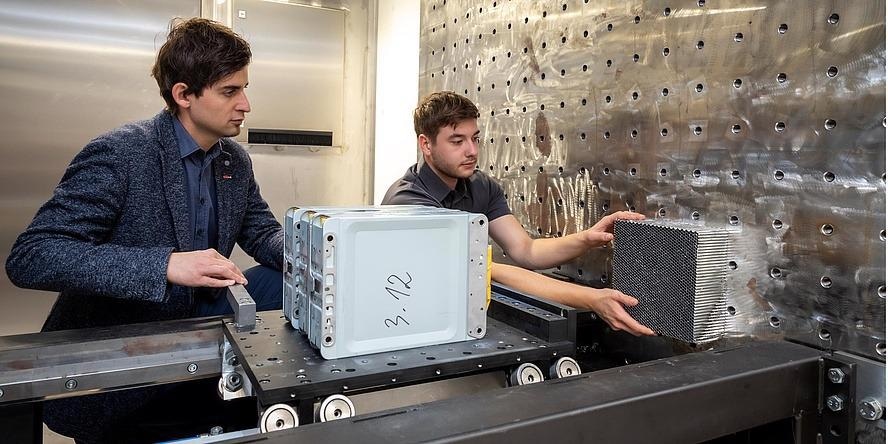May 4 2021
Over the last four years, a research team from Graz University of Technology (TU Graz) has been examining the behavior of lithium-based batteries in electric cars under crash loads. This was done as part of the project called “SafeBattery.”
 Batteries in electric vehicles become safer with age. In the photo: Project manager Christian Ellersdorfer from TU Graz with colleague Christian Trummer at the highly dynamic crash system, located in the Battery Safety Center Graz. Image Credit: © Lunghammer – TU Graz.
Batteries in electric vehicles become safer with age. In the photo: Project manager Christian Ellersdorfer from TU Graz with colleague Christian Trummer at the highly dynamic crash system, located in the Battery Safety Center Graz. Image Credit: © Lunghammer – TU Graz.
The performance of new battery cells is largely known, so we dealt with the entire life cycle.
Christian Ellersdorfer, Project Manager, Institute of Vehicle Safety, TU Graz
Collaborating with industry partners like Audi, Daimler, and AVL, the study was performed on scenarios in which a battery can undergo, in the path of its life, for instance, strong accelerations and vibrations due to serious accidents, parking bumps, and the persistent charging and discharging of batteries.
Changes Due to Charging and Discharging
Using simulation models, crash tests, and calculation techniques, the team could identify that accelerations and vibrations barely impact the behavior of batteries. But more considerable electrical and mechanical variations were observed due to the regular charging and discharging of the battery. Battery cells that aged in this way possess a higher stiffness under mechanical load.
But the changes don’t necessarily mean that batteries become more dangerous with age. On the contrary. The sum of the influences makes them safer over time because they also lose electrical energy.
Christian Ellersdorfer, Project Manager, Institute of Vehicle Safety
Tests Ellersdorfer and colleagues demonstrate that cells with considerably decreased capacity content have a weakened course of the alleged thermal runaway following an internal short circuit. Hence, a decline in the energy potential of the aged batteries reduces the probability of battery fires that take place accidentally.
Benefit for Automotive Industry
As a result of the study findings, manufacturers have come to an idea as to what they can anticipate from a battery cell. This allows material-saving designs and higher efficiency.
Until now, the battery was installed in such a way that deformations could be ruled out in every conceivable scenario. Now manufacturers can make better use of the installation space. And safety checks on a new cell are valid for the life of the battery.
Christian Ellersdorfer, Project Manager, Institute of Vehicle Safety
Approval of EVBs for a Second Life
In the timeframe of a battery’s life, the SafeBattery consortium currently goes one step ahead. In the COMET project called SafeLIB that has been launched recently, the variations in traction batteries for electric vehicles are being analyzed more in-depth jointly with other collaborators (Fronius, LIT Law LAB, Mercedes, and Infineon) to be able to infer safety factors for later use.
“Used batteries with a power capacity of 80 percent are no longer suitable for electric vehicles, but they are very suitable for stationary energy storage or for machine tools. For the first time, we are determining generally valid parameters in the area of safety,” stated Ellersdorfer, explaining the project.
The scientists will make use of the only test bench technology in the world for battery safety at the Battery Safety Center Graz, which was launched at the end of 2020. There, the battery cell’s early life can be analyzed at an unparalleled level of detail. The legal framework for re-usability (for example, the question of responsibility for resultant damage) is also considered.
Besides the purported “state of health,” which reflects the present performance and residual capacity of a battery cell, a “state of safety” must eventually be defined, by which the safety status of a battery can be evaluated over the whole life cycle.
SafeLIB will operate for four years and end in 2025. The Austrian Research Promotion Agency FFG is financially supporting the project with a sum of 6 million euros.